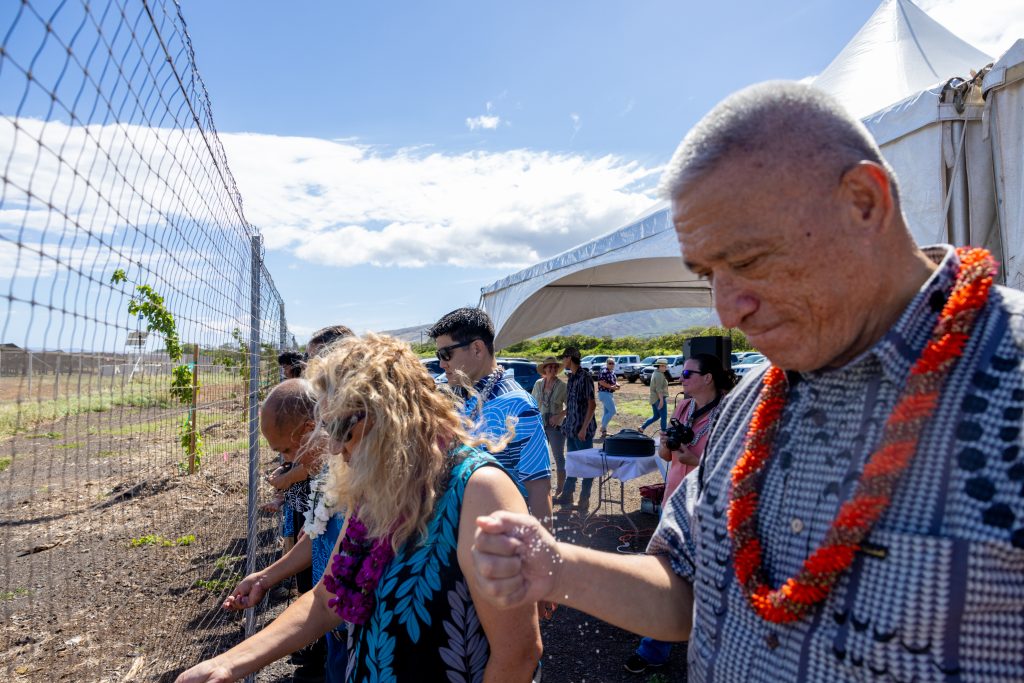AES Hawaiʻi launches Kūihelani Solar-Plus-Storage in Central Maui—Hawaiʻi’s largest solar power facility : Maui Now

[ad_1]

AES Hawaiʻi held a blessing ceremony on Friday to launch Kūihelani Solar-Plus-Storage, Hawai‘i’s largest solar facility, which is producing electricity for Maui at 8-cents per kilowatt hour, the lowest renewable energy cost in the state.
Located on 450 acres in central Maui, Kūihelani Solar-Plus-Storage is producing 60 MW of renewable energy supported by a 240 MWh lithium-ion battery energy storage system, which is generating enough electricity for 27,000 homes, providing 15% of Maui’s energy needs. The project also offsets the need to import two million barrels of oil to produce electricity.
Bernerd Da Santos, Executive Vice President and President of Global Renewables for The AES Corporation (AES), said the commissioning of AES Hawai‘i’s newest renewable energy facility is a distinctive achievement for a global company with both established and new energy operations underway around the world.

“Kūihelani demonstrates what can be accomplished when a focused company collaborates with government and industry partners to maximize the production of clean, renewable solar power and does so at a cost that is lower than anywhere else in Hawai‘i,” said Da Santos. “Everyone wins with this project, Maui County, the State of Hawai‘i, Hawaiian Electric, and, most of all, the people of Maui who want and expect their power be generated effectively, efficiently and inexpensively for future generations.”
Numerous elected officials, community leaders and partners participated in the blessing ceremony in recognition of the project’s impact on Maui’s power grid and the island’s economy.
This included Maui County Mayor Richard Bissen, Maui County Council Chair Alice Lee, Maui County Councilmember Tom Cook, State Senator Lynn DeCoite, State Representative Tyson Miyake, Public Utilities Commission Chair Leodoloff Asuncion, and Hawaiian Electric President and CEO Shelee Kimura.
The Kūihelani Solar-Plus-Storage facility began commercial operations on May 31, 2024, and has since generated more than 75,000 MW for Maui’s power grid, or an average of 841 MW on a daily basis. In addition, the project’s construction and operation have supported nearly 300 jobs and generated $68 million for Maui’s economy.
In recognition of Kūihelani’s beneficial impact on Maui’s renewable energy future, Mayor Bissen presented Da Santos and AES Hawai‘i with a proclamation declaring Sept. 6, 2024, as Energy Resiliency Day for the County of Maui.

AES Hawai‘i President Sandra Larsen expressed appreciation for the widespread support that the company has received for its first utility-scale solar project on Maui, and also for the 25-year power purchase agreement with Hawaiian Electric.
Larsen said, “Our collective team’s intent at AES Hawai‘i is always on the future and how our production of clean, renewable energy can make the enjoyment and affordability of life in Hawai‘i a better and more promising outlook for families and children. The outstanding support we have received from trusted community partners, like Maui County, Hawaiian Electric, and our Maui-based contractors, have made it possible to launch Kūihelani and enabled us to generate low-cost renewable energy for Maui for the next 25 years.”
Kimura noted the launch of Kūihelani Solar-Plus-Storage is an important success story in the utility’s decade-long work to attract developers like AES Hawai‘i to broaden the renewable energy portfolios on each island. “By creating the market for partners like AES Hawai‘i and designing long-term contracts that benefit customers, we will continue to see projects that meet a critical need for renewable generation and make progress toward our state’s goals for renewable energy and reduced carbon emissions,” Kimura said.
Larsen added that the project’s 450 acres are being effectively utilized to help bolster Maui’s agricultural and food production needs, as AES Hawai‘i is partnering with Ho‘oulu ‘Āina Farms in Waikapū to have sheep graze on the land. “We’re pleased with the positive impact that Kūihelani and its dual-use capabilities are contributing to Maui’s quality of life,” said Larsen.




